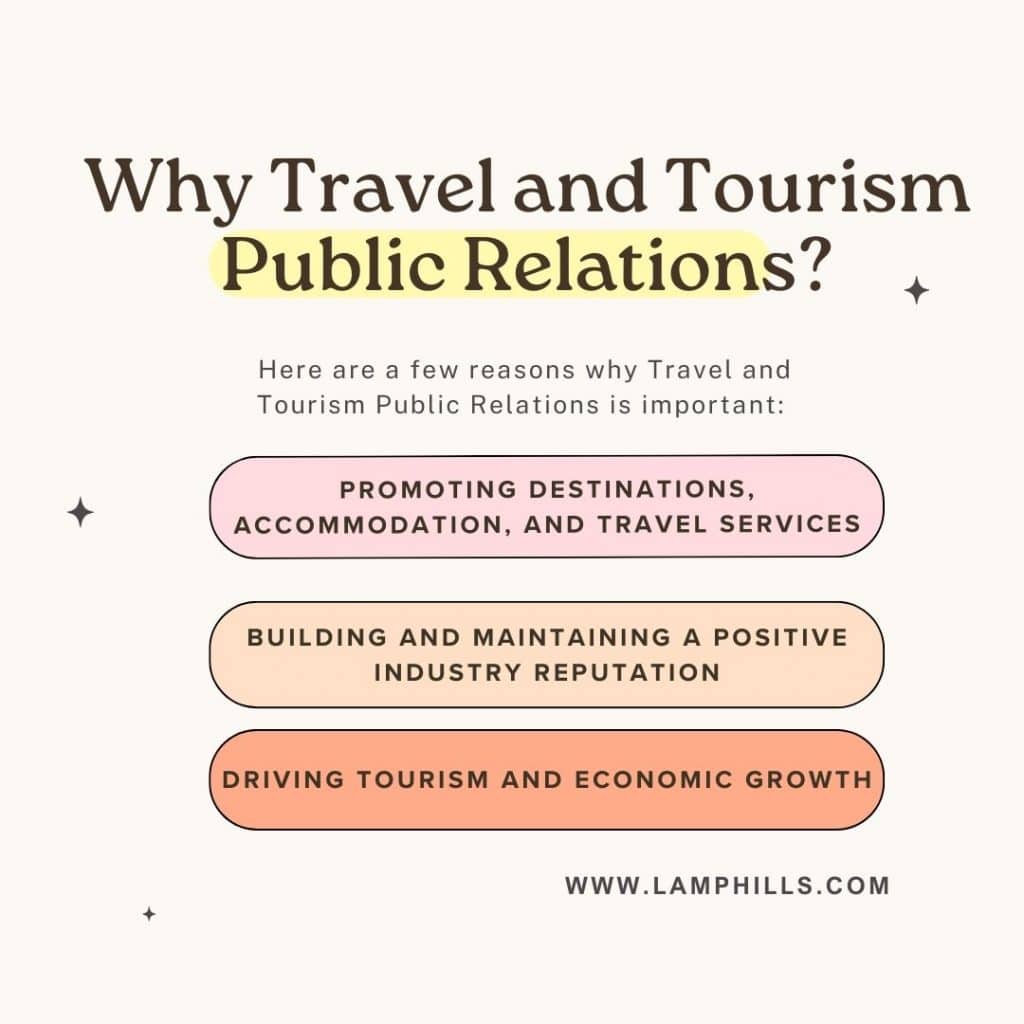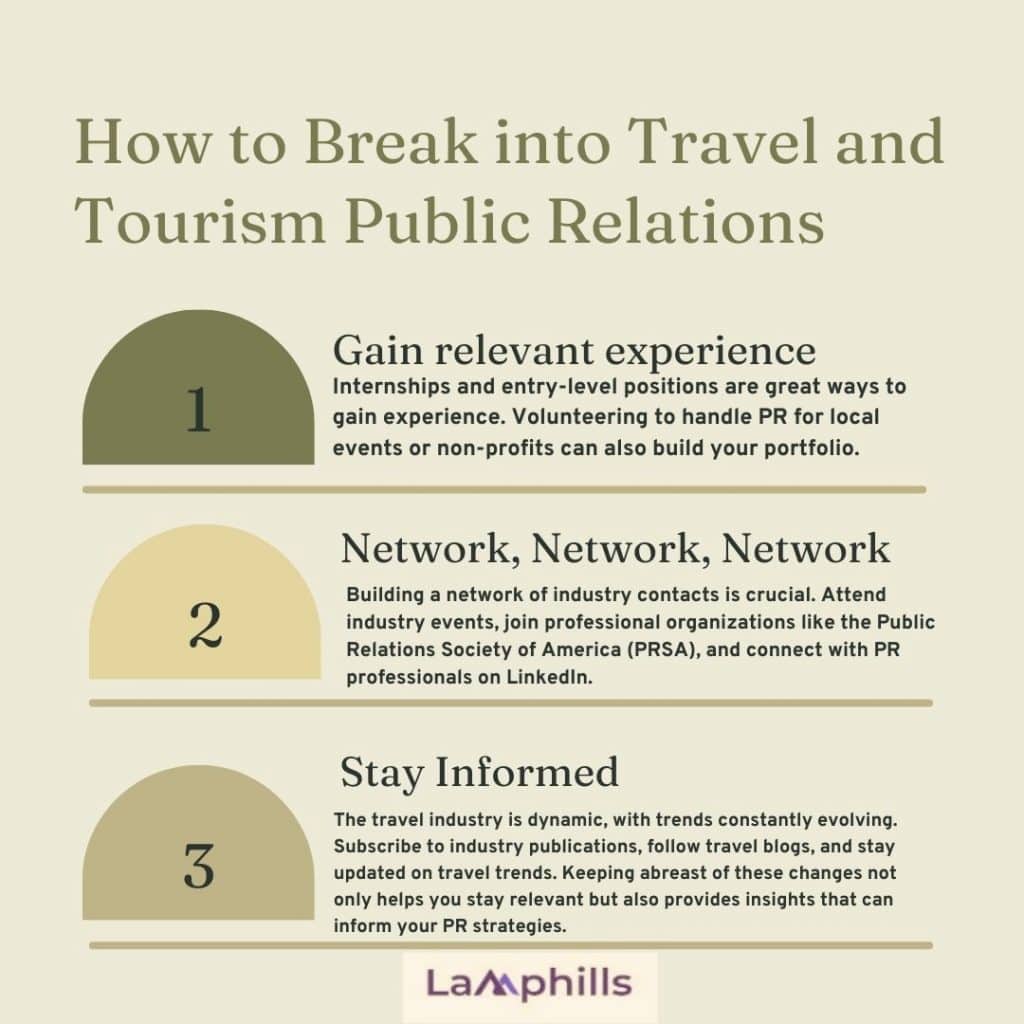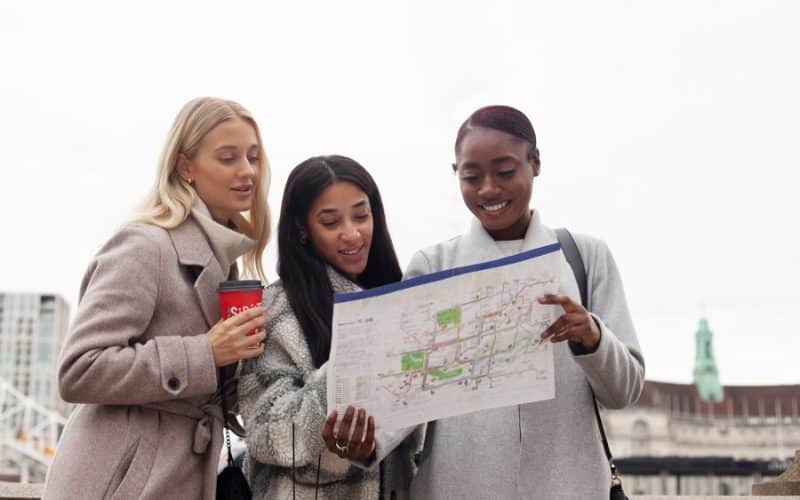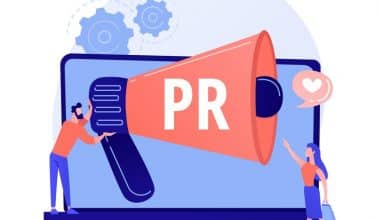Travel Public Relations (PR) is more than just getting your brand mentioned in a few travel magazines or websites. It’s about telling a captivating story that connects with your audience, builds trust, and, ultimately, increases bookings. Whether you run a boutique hotel in Bali or a luxury cruise line, smart public relations can help you stand out in the competitive travel market. Let me educate you on what Travel Public Relations entails, the best agencies to work with, and the various opportunities in this exciting field.
Key Takeaways
- Travel Public Relations is centered around storytelling to create captivating narratives that connect with the audience, build trust, and increase bookings. This involves painting a vivid picture that transports potential travelers to a destination before they even visit.
- Effective PR campaigns can significantly impact a travel brand’s success. From attracting bookings and increasing brand awareness to building a positive reputation and managing crises, travel PR plays a vital role in the travel and tourism industry.
- Choosing the right PR agency matters. Partnering with a reputable travel PR agency with expertise in your specific niche can make a big difference. I highlight several top agencies and the unique strengths they bring to the table.
- Building and maintaining relationships with travel writers, bloggers, and influencers is crucial. These relationships are the backbone of successful PR campaigns, as they help in authentic and engaging storytelling that resonates with a broader audience.
What is Travel Public Relations?
Travel Public Relations involves managing the public image and communication strategies of travel-related businesses. This category includes hotels, airlines, tourism boards, and travel agencies.
The goal is to increase positive media coverage, improve brand reputation, and establish a strong relationship with your target audience. PR experts do this through various channels, such as press releases, media events, influencer partnerships, and crisis management.
Travel and tourism Public Relations is all about storytelling. It’s about creating a picture that transports the audience to a destination before they even pack their bags. This narrative not only attracted eco-conscious travelers but also garnered attention from travel bloggers and journalists who are eager to share these stories with their audiences.
Another important component of travel PR is developing and sustaining relationships with travel writers, bloggers, and influencers. These relationships are the backbone of any successful PR campaign.
For instance, when my friend was launching a new luxury travel package, he collaborated with a well-known travel influencer. By giving them a firsthand experience, complete with behind-the-scenes access and personalized touches, they were able to share an authentic and engaging story with their followers, resulting in a large boost in bookings.
Why Travel and Tourism Public Relations?

The mission of Travel and Tourism Public Relations is multidimensional, with each component essential for the success of the industry’s various players. It’s much more than just attracting attention; it’s about creating an interesting image that stimulates and holds the traveler’s interest. Here are a few reasons why Travel and Tourism Public Relations is important:
#1. Promoting destinations, accommodation, and travel services:
The primary goal of travel and tourism public relations is to promote and elevate destinations, accommodation, and travel services to generate interest and bookings. This is accomplished by a smart mix of presenting a location’s unique selling features, emphasizing its culture and experiences, and providing a narrative that resonates with potential visitors. The goal is to create a stunning image that captivates the mind, sparks curiosity, and positions the destination or service as a must-visit.
#2. Building and maintaining a positive industry reputation:
Travel PR seeks to build and maintain a positive image for travel brands, destinations, and organizations. This includes promoting accomplishments, environmental efforts, community activities, and service quality, all of which contribute to a credible image in the public eye.
A strong, favorable reputation promotes trust and reliability, both of which are important factors in customer travel decisions. PR experts seek to build positive relationships with stakeholders, manage customer expectations, and neutralize negative opinions that could harm the brand, assuring the durability and profitability of travel businesses in a highly competitive industry.
#3. Driving tourism and economic growth:
Beyond brand perception, travel and tourism public relations play a crucial role in increasing tourism numbers and supporting economic growth in regions and countries. PR strategies that effectively sell places and create enticing narratives can directly affect travel intent and decisions, resulting in higher tourist numbers and tourism revenue.
Strategic public relations campaigns are intended to draw attention to regions during peak seasons, promote off-season tourism, and diversify tourist attractions to balance visitor spread and maximize economic benefits. These efforts not only benefit the tourism industry, but they also have a knock-on effect on local economies, helping businesses and creating jobs.
Best Travel Public Relations Agencies
Choosing the right PR agency can make all the difference. Here are some of the top travel PR agencies known for their expertise and results:
#1. Hills Balfour:
Hills Balfour is renowned for its strategic and creative approach to travel PR. They’ve worked with some of the biggest names in the industry, including destinations like Dubai and Mauritius. Their comprehensive services include media relations, digital marketing, and crisis management. A colleague of mine worked with Hills Balfour to promote a new boutique hotel in the Maldives. The agency’s ability to secure high-profile media coverage and influencer endorsements was instrumental in putting the hotel on the map.
#2. MMGY Global:
MMGY Global specializes in integrated marketing solutions for the travel and hospitality industries. They offer a wide range of services from PR and social media to creative and research. I know of someone who collaborated with MMGY Global on a campaign for a Caribbean resort. Their data-driven approach and deep understanding of travel trends helped them craft messages that resonated with their target audience, resulting in a noticeable uptick in guest inquiries and bookings.
#3. Turner PR:
Turner PR focuses on lifestyle and travel brands, offering services such as media relations, influencer marketing, and content creation. They are known for their innovative campaigns that capture the essence of a brand. For example, I read a publication about a person who owns a luxury safari lodge in Africa partnered with Turner PR. The agency’s creative storytelling and media outreach led to features in top-tier publications like Conde Nast Traveler and National Geographic, significantly boosting the lodge’s visibility and prestige.
#4. Perowne International:
In a society enchanted with the biggest and the glossiest, Jules Perowne dares to disagree, relying on word-of-mouth fame that luxury hospitality businesses dream of. Her hidden weapon? A bit of wanderlust. Perowne’s staff are world travelers by trade, believing that seeing is the only way to properly understand.
This approach keeps them in tune with the desires of the world’s most affluent travelers. The outcomes speak for themselves. Raffles London is a $1.7 billion extravaganza featuring nine restaurants, three lounges, and hotel suites named after iconic personalities such as Winston Churchill. Not to mention their Lake Como jewel, Passalacqua, which won first place in the inaugural World’s 50 Best Hotels Awards.
#5. GO PR:
In just three years, industry maven Gizem Ozcelik has propelled GO PR to the peak of innovation. Exhibit A is the debut of Hotel Marcel, the first net-zero emissions hotel in the United States, which received over 11 billion impressions across various media channels, including travel and business. This project, along with relationships with environmentally minded destinations such as Tourisme Montréal and Visit Faroe Islands, exemplifies GO PR’s green streak.
The agency’s knack for fresh, buzzworthy campaigns shone in 2023 with the highly anticipated revival of Dawn Ranch near Sonoma (racking up a whopping 693 million impressions in six months) and the monthly themed—not to mention sold-out—Astrology Dinners at Society Cafe in The Walker Hotel Greenwich Village. According to Ozcelik, it is about looking beyond standard hospitality public relations goals.
Luxury Travel Public Relations
Luxury travel PR is a niche within the industry that requires a tailored approach. High-end travelers expect exclusivity, personalization, and exceptional experiences. As a result, PR strategies must reflect these expectations.
#1. Crafting an aura of exclusivity:
When promoting luxury travel, it’s essential to create an aura of exclusivity. This can be achieved through high-quality content, VIP events, and partnerships with luxury brands. I recall a campaign for a luxury yacht charter company where a brand we partnered with organized an exclusive event at the Monaco Yacht Show. Inviting a select group of high-net-worth individuals and influential media not only generated buzz but also positioned the company as a leader in the luxury travel sector.
#2. Making use of influencers and celebrities:
Partnering with influencers and celebrities can amplify your message and reach a wider audience. For instance, I know a company that collaborated with a well-known actress during a campaign for a five-star resort in Bora Bora. Her posts about her stay, combined with professional photography and behind-the-scenes videos, went viral, attracting affluent travelers from around the world.
#3. High-end media placements:
Securing placements in prestigious media outlets is crucial for luxury travel and tourism Public Relations. Publications like Vogue, Robb Report, and Travel + Leisure are highly influential among luxury travelers. Working with these outlets requires not only strong relationships but also providing unique and newsworthy content.
Travel Public Relations Jobs
The field of travel Public Relations offers a variety of career opportunities, from entry-level positions to senior roles. Here are some common job titles and what they entail:
- PR Coordinator: A PR Coordinator typically handles administrative tasks, media monitoring, and drafting press materials. This entry-level role is perfect for recent graduates looking to break into the industry.
- PR Manager: A PR Manager is responsible for developing and implementing PR strategies, managing media relations, and overseeing campaigns. This role requires several years of experience and a proven track record in PR.
- Account Director: An Account Director oversees multiple clients and ensures that all PR activities align with their business goals. This senior role involves strategic planning, team management, and high-level client relations. A former colleague who advanced to Account Director at a leading travel PR firm shared that the key to success in this role is balancing creative vision with business acumen. Her expertise in both areas allowed her to drive impactful results for her clients.
- Vice President of PR: The Vice President of PR leads the overall PR strategy for an organization, manages senior relationships, and plays a pivotal role in business development. This executive role demands extensive experience and leadership skills. A mentor of mine, who became the VP of PR for a global hotel chain, emphasized the importance of visionary thinking and the ability to inspire and guide large teams.
How to Break into Travel and Tourism Public Relations
Breaking into travel PR can be challenging but immensely rewarding. Here are some steps to get started:

The Impact of Digital Media on Travel and Tourism Public Relations
Digital media has revolutionized the way travel PR operates. Social media, blogs, and online reviews play a significant role in shaping public perception and driving consumer behavior.
#1. The Role of Social Media:
Social media platforms like Instagram, Facebook, and Twitter are vital tools for travel PR. They offer a direct line of communication with your audience and an opportunity to showcase your brand’s personality. For example, during a campaign for a cruise line, we used Instagram Stories to give followers a behind-the-scenes look at life onboard. This real-time engagement not only increased followers but also generated excitement and anticipation among potential travelers.
#2. Influencer Marketing:
Collaborating with travel influencers can extend your reach and add credibility to your brand. Influencers have loyal followers who trust their recommendations, making them valuable partners for PR campaigns. When promoting a new adventure travel company, partner with influencers known for their thrill-seeking adventures. Their authentic content and enthusiastic endorsements will lead to a surge in inquiries and bookings.
#3. Online Reviews and User-Generated Content:
Online reviews and user-generated content (UGC) are powerful tools in travel PR. Positive reviews on platforms like TripAdvisor and Yelp can significantly impact your brand’s reputation. Encouraging satisfied customers to share their experiences can generate organic, authentic content that attracts new travelers.
Download Lamphill’s Checklist Here
Crisis Management in Travel and Tourism Public Relations
No matter how well-planned a PR strategy is, crises can and do happen. Effective crisis management is essential to protect your brand’s reputation and maintain trust with your audience.
#1. Preparation is important:
The best way to handle a crisis is to be prepared for it. This involves having a crisis management plan in place, complete with predefined roles, communication protocols, and messaging templates. When my brand was working with an airline, we faced a crisis when a major flight disruption occurred. Thanks to our comprehensive crisis management plan, we were able to respond swiftly and effectively, keeping passengers informed and minimizing negative media coverage.
#2. Transparent communication:
During a crisis, transparency and timely communication are crucial. Acknowledge the issue, provide regular updates, and be honest about the steps being taken to resolve it. During a PR crisis at a luxury resort due to a health and safety concern, we maintained open lines of communication with guests and media. By being transparent and proactive, we rebuilt trust and restored the resort’s reputation.
#3. Post-crisis analysis:
After the crisis has been managed, it’s important to conduct a thorough analysis to understand what went wrong and how similar situations can be prevented in the future. This includes reviewing the crisis management plan, assessing the effectiveness of the response, and making necessary adjustments. Following the airline crisis I mentioned earlier, we held a debriefing session to evaluate our response and improve our strategies for future incidents.
What do you do in travel PR?
As a travel PR specialist, your role is to help destinations, hotels, resorts, and travel companies share their stories and attract visitors. Here are some of the things you do:
- Media Relations: You connect with travel journalists, influencers, and bloggers to share your clients’ stories and secure press coverage.
- Crisis Communications: If a crisis occurs, like a natural disaster or travel disruption, you help your clients manage the situation and communicate effectively with the public.
- Social Media: You develop social media strategies and create engaging content to showcase your clients’ destinations and experiences.
- Content Creation: You write and produce compelling content like press releases, media kits, and travel guides to inspire travel and drive bookings.
- Reputation Management: You monitor and manage online reviews and feedback to maintain your clients’ reputations and improve their services.
- Events and activations: You organize events, family trips, and activations to showcase clients’ offerings and build relationships with industry partners.
- Strategy and Research: You conduct market research and analyze travel trends to develop effective client PR strategies.
Download Lamphill’s Checklist Here
Conclusion
Travel public relations is a dynamic and satisfying business with several opportunities to create impactful stories and build long-lasting relationships. The function of public relations in the travel business is complex and crucial, ranging from creating appealing stories to resolving disasters. Whether you’re just getting started or want to boost your brand’s public relations efforts, grasping the complexities of travel public relations can help you succeed.
So, what are your ideas on travel PR? Have you seen the results of a well-executed public relations campaign? Please share your experiences with me and let’s have a discussion!
Related Articles
- What Is a Press Trip? An Explanatory Guide for Travel Writers and Bloggers for 2024
- TOP 13 TRAVEL INFLUENCERS TO FOLLOW IN 2024
- Leveraging Different Forms of Media for Business Growth
- Easy PR Lists to Get On: A Minimal Effort Guide for Influencers
- Integrated Communication in the Digital Age






